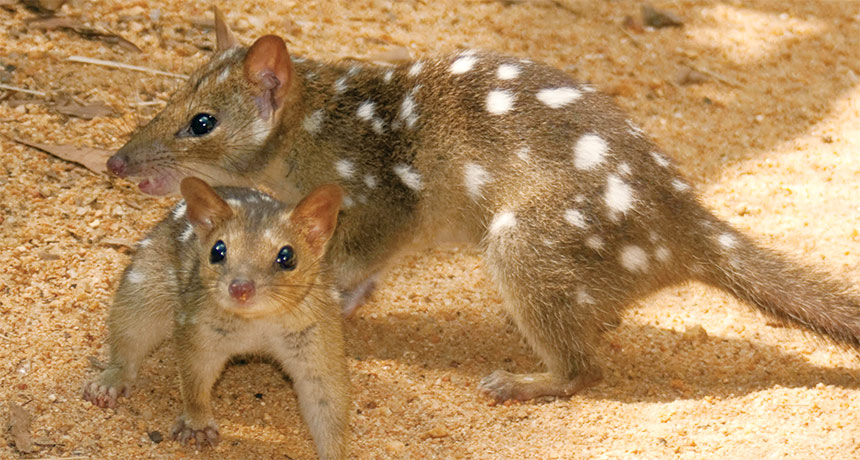
Quoll Sleep and Mating: Behavioral Insights
Quolls, nocturnal marsupials native to Australia and New Guinea, exhibit fascinating behavioral patterns in relation to sleep and mating. These small carnivorous mammals are known for their solitary habits and agile hunting skills. In terms of sleep behavior, quolls typically rest during the day in dens or secluded areas, emerging at night to forage for food. Their sleep patterns are influenced by environmental factors such as temperature and food availability, with individuals adjusting their activity levels accordingly. During mating seasons, quolls display complex behaviors related to courtship and reproduction, including vocalizations, scent marking, and aggressive interactions among males competing for females. Understanding these behavioral insights provides valuable insights into the ecological roles and reproductive strategies of quolls within their natural habitats.
Nocturnal Activity and Resting Patterns
Quolls are primarily nocturnal, meaning they are most active during the night hours when they hunt for prey such as insects, small mammals, birds, and reptiles. Their nocturnal behavior is an adaptation that helps them avoid predators and efficiently locate food sources in dim light conditions. During the day, quolls typically retreat to dens or nest sites located in tree hollows, rock crevices, or underground burrows, where they rest and conserve energy. Resting periods are crucial for quolls to recover from nocturnal activities and maintain their physiological functions, including digestion, thermoregulation, and grooming. The duration and quality of their sleep may vary depending on factors such as environmental disturbances, social interactions, and reproductive status, highlighting the flexibility of their sleep patterns in response to external stimuli.
Reproductive Cycles and Mating Behaviors
Quolls exhibit distinct reproductive cycles and mating behaviors that vary among species and geographic regions. Most quoll species are polygynous, with dominant males competing for access to females during breeding seasons. Mating behaviors often involve elaborate courtship displays, vocalizations, and scent marking to attract potential mates and establish dominance hierarchies. Male quolls may engage in aggressive encounters with rival males to assert mating rights and protect territories, while females assess male fitness and suitability as mates based on physical condition and behavioral displays. Successful mating events result in pregnancies lasting several weeks, followed by the birth of tiny, underdeveloped joeys that continue to develop in the safety of the mother’s pouch until they are mature enough to venture out on their own.
Parental Care and Offspring Development
Parental care is crucial for the survival and development of quoll offspring, particularly during the early stages of their lives. Female quolls provide extensive care to their young, nursing joeys in the pouch until they are weaned and capable of independent foraging. During this period, mothers protect their offspring from predators, regulate their body temperature, and teach essential hunting and survival skills. Male quolls may play a limited role in parental care by defending territories and providing occasional protection, although their involvement varies among species. Offspring development progresses from dependency on maternal care to gradual independence, as young quolls learn to hunt, navigate their environment, and establish their territories as adults. This process contributes to the maintenance of quoll populations and the transmission of behavioral traits essential for their survival in dynamic and competitive ecosystems.
Dietary Preferences and Foraging Strategies
Quolls are carnivorous mammals with diverse dietary preferences and foraging strategies adapted to their natural habitats. Depending on species and geographic location, quolls consume a wide range of prey items, including insects, small mammals, birds, reptiles, and occasionally fruits or vegetation. Their foraging behaviors are influenced by prey availability, seasonal fluctuations, and habitat characteristics, prompting quolls to adapt their hunting strategies and dietary intake accordingly. Agile and opportunistic hunters, quolls use their sharp claws, keen sense of smell, and nocturnal vision to locate and capture prey efficiently. This dietary flexibility allows quolls to exploit diverse food resources and maintain balanced nutrition essential for energy metabolism, growth, and reproductive success within their ecological niches.
Conservation Challenges and Habitat Threats
Despite their ecological significance, quoll populations face numerous conservation challenges and habitat threats that jeopardize their long-term survival. Habitat loss and fragmentation due to urbanization, agriculture, and land clearing diminish available habitat and restrict quoll movements, leading to reduced foraging opportunities and increased vulnerability to predation. Competition with invasive species, such as feral cats and foxes, further exacerbates predation pressure and limits prey availability for quolls. Climate change impacts, including altered temperature patterns and habitat suitability, also pose significant threats to quoll populations by disrupting their breeding cycles, food availability, and overall ecological resilience. Conservation efforts focused on habitat restoration, predator control, captive breeding programs, and public awareness initiatives are essential for safeguarding quoll species and preserving their unique behavioral adaptations in their natural environments.
Vote
Who is your all-time favorite president?
Research Opportunities and Future Directions
Advancements in research technologies and methodologies offer promising opportunities to deepen our understanding of quoll behavior, ecology, and conservation needs. Integrating GPS tracking, genetic analysis, and remote sensing techniques can provide valuable insights into quoll movements, habitat preferences, and population dynamics across different landscapes. Long-term monitoring studies and ecological modeling efforts can help predict the impacts of environmental changes on quoll populations and inform adaptive management strategies aimed at mitigating conservation challenges. Collaborative research partnerships between scientists, conservation organizations, and local communities are essential for generating scientific knowledge, promoting evidence-based conservation practices, and fostering public engagement in quoll conservation efforts. By leveraging interdisciplinary approaches and innovative solutions, stakeholders can work together to ensure a sustainable future for quoll species and their habitats amidst ongoing environmental pressures and global challenges.